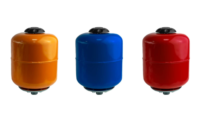My first service call to their three-story row home in the Avenues area of my hometown York, Pennsylvania was for no heat. Parking is always a challenge, and the only available space was halfway down the block. Exiting the truck, I could smell the Mercaptan odor from a natural gas leak. Note to self: contact the gas company ASAP. Taking along my standard flashlight, 4-way screwdriver, adjustable water-pump pliers, and multimeter for the initial start of all HVAC related service calls, I walked to the home and rang the doorbell.
They showed me to the basement stairway and as I descended the stairs, an acrid odor from several cat litter boxes made my eyes tear up! All three had been unchanged for a long period of time, and as cats will do, they had moved on to leave their cat diamonds behind the boiler and water heater! The boiler’s pilot was out and the automatic gas valve had failed — in the open position! 150,000-Btu/h of raw natural gas was spewing forth, and, fortunately for them, up the chimney. Note to self: no need to call the gas company because I had found the gas odor source. I was glad the gas water heater was not firing as the flues both joined up with the chimney. Fortunately, I carried several automatic gas valves on my truck and could provide repairs and restoration of their heat.
They became a regular customer and the kitty litter boxes in their basement remained unchanged. The basement consisted of two large rooms with loads of junk scattered about and a large Chifforobe, a closet-like piece of furniture, sat against the common wall between the two rooms. The stench-odor was always overwhelming — plumbers need strong stomachs! With two small children and one on-the-way, I was puzzled as to why they let what seemed like an obvious health hazard be present.
Returning from our family vacation, skimming the morning editions of our local paper, we spied an article on the front page with the wife’s picture and a caption that said “We just want our baby back.” She was wearing a T-shirt that stated in bold letters emblazoned across it, “her real last name” followed by “Did It.” The article detailed the kidnapping of their newborn child. Looking at the mother’s picture on the front page and looking into her eyes that stared back at you, I told my wife I didn’t believe the baby was kidnapped and you could see in her eyes — the window to your soul — that she had murdered the baby.
As the days passed, the search continued and more articles chronicled the sad saga. The police had searched their home twice but found nothing. I told my wife you could have hidden the child’s body in that basement Chifforobe and no one would know because the stench from the litter boxes would mask the odor of a decomposing body. Early in the morning, the day of trash collection, the mother carried a trash bag to the alley behind their home and put it in the trash can for pickup. The police had been watching the home and witnessed her depositing the trash bag in the can, retrieved it, and it held the remains of her baby. After her arrest, she confessed to having deliberately placed the baby in scalding hot water in their bathtub, walked awa, and murdered her child.
She was convicted and sent off to the women’s prison to serve out her sentence.
Way back in the 1980s, gas water heater manufacturers reset the control to 120° F, down from 140° F. That certainly left an indelible impression on me as suddenly a 40-gallon gas-fired water heater replacement led to complaints about running out of hot water. We quickly learned it was necessary to replace the 40-gallon models with a 50-gallon model. Dishwasher manufacturers had to add a sanitizing rinse feature whereby a heating element raised the retained rinse-water up to 140° F for the final rinse. In spite of lowering the water temperature from 140° F to 120 °F, thermal scalding continued unabated with an average of 160,000 incidents each year requiring medical attention. I wrote a series of articles regarding thermal scalding, which led to Watts contracting for a 28-minute documentary, Danger – Scalding Lurks, on thermal scalding issues with what could be done to minimize this well-known public health risk.
After several decades passed, the mom who murdered the infant by thermal scalding was released from prison. A few years later, the husband called asking to have several faucets repaired and left a key under the front doormat. They arrived home before I finished and he asked if I could check their electric water heater because they were running out of hot water in the mornings while showering before heading off to their jobs.
I removed the upper and lower access panels covering the upper and lower heating elements to check voltage and amp-draw for each element, which checked out as functioning normally. Standard practice includes testing for voltage across the two “hot” terminals for the 220-volt power, which is seldom the actual voltage and can be over or under 220. I also check each terminal to ground to ensure both legs are “hot.” By measuring and recording the amp-draw, the actual real-world wattage of the heating elements can be determined. The voltage was 235 and the amp-draw was 18.8 for each element. Volts x amps = watts, which equaled 4,418. 4,418 x 3.412 (Btu/h per watt) equals 15,074.216 Btu/h for recovery to heat incoming cold water. Raising one gallon of cold water from 40° F (design conditions) to 120° F requires 667.2-Btu/h resulting in a net 22.59-gallons-per-hour recovery rate. They won’t see the full 50-gallons of heated water due to entry and mixing of cold water, which when coupled with their bathing habits and duration of use revealed why they were running out of hot water.
“Can’t you just adjust the thermostats to raise the water temperature, which would allow us to avoid running out of hot water?” Without batting an eye, I launched into my well-worn script from memory I always utilized when addressing the potential dangers and I was mid-sentence on the increased risk of thermal scalding for infants and the elderly by raising the storage temperature when it dawned on me just who I was talking to about thermal scalding dangers. A chill ran down my spine. I declined to raise the storage temperature. They never called me again for PHVAC work following that call.
It’s acceptable to raise the hot water storage temperature if you incorporate temperature-balancing scald-guard devices either at the point-of-source, or better still, at all points of use where human contact will occur. I maintain our indirect water heater storage temperature at 140° F, not for extending usage times but due to concerns about bacterial amplification because storage tanks, even held at 120° F, are a known amplifier for nasty bugs like the Legionella bacterium. Instead of a single thermostatic mixing valve at the outlet of our storage tank, we have thermal scald-guard ASSE code-compliant devices at the points of use in our home. The faucets our grandchildren have access to are set for 110° F. Our scald-guard thermostatic mixing valves are deliberately installed just a few feet away from the faucets they serve to minimize bacterial amplification concerns.




